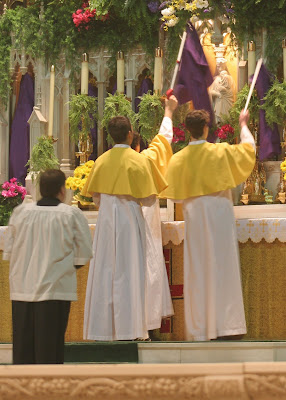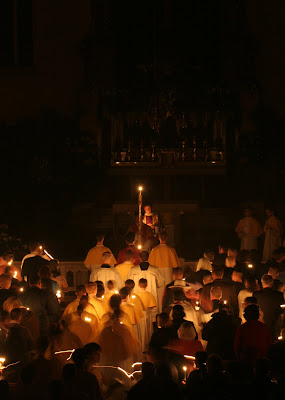
Good Friday always starts out somewhat sparsely populated in the pews. But within an hour or so, there was no room left for sitting. Chairs were brought out for people standing in the back, many of whom camped out on the floor.
This is a photo story of the Good Friday Liturgy celebrated at Assumption Grotto according to the 1962 Missal.
Unlike previous years when it all began with a long procession from the back, the priest and acolytes came out from the sacristy directly into the sanctuary in total silence.

The priests then prostrated themselves at the foot of the altar. It is a sign of total humility and penance. It was also used by the priests at the rite of ordination.

The sub-deacon reads the Second Lesson (Ex 12:1-11)

 This is probably a good time to note that something was noticeably missing - at least to me. They are called the solita oscula. You may have noticed in the TLM when the deacon hands something to the celebrant, such as his biretta, he first kisses the biretta, then the hand of the celebrant. When he takes something from him, he does the opposite - kisses the celebrant's hand, then the object (h/t to Fr. Tim Finigan who explained it in this linked combox).
This is probably a good time to note that something was noticeably missing - at least to me. They are called the solita oscula. You may have noticed in the TLM when the deacon hands something to the celebrant, such as his biretta, he first kisses the biretta, then the hand of the celebrant. When he takes something from him, he does the opposite - kisses the celebrant's hand, then the object (h/t to Fr. Tim Finigan who explained it in this linked combox).
On Good Friday, the solita oscula are omitted, as are salutations to clergy in choir (Ceremonies of the Roman Rite Described, 2003). More on this and why it is done in a later post.







The Gospel reading, the Passion of Our Lord, was sung by the three priests. I have video of this and will see how well it came out for uploading at least segments of this.





After the sermon was done, the priests vested in black for the Great Intercession prayers




Next came the unveiling and Adoration of the Cross. This was also a switch from what we have seen in the past, before we began using the 1962 missal. Grotto-goers may recall that the Cross was brought up from the rear, being unveiled a little more each time it stopped along the way to the sanctuary. This time, it was done completely in the sanctuary. I thought it was better because we could see all that was going on. Not only that, it reminded me more of the way to Calvary with the final stop about as high up the altar steps as they could go.


I don't recall seeing this before, but the priests removed their shoes with the help of the acolytes before they kissed the Cross.

Here, the deacon kisses the Cross as the sub-deacon waits.

Altar boys then line up and do the same.....

....followed by the laity using Crosses at the center, and both side altars.

When the Adoration of the Cross was complete, it was time for Communion. The deacon prepares the altar and then leaves to get the Consecrated Hosts stored for use today.



This picture blurred because of motion, but you may have noticed that when the Blessed Sacrament was brought out by the deacon. The ombrellino was used. It is the same as a canopy, except smaller and more portable.



Here, we see the crotalus, or clapper, about to be used. Actually, he was holding two of them and when Fr. Perrone prayed the "Domine non sum dignus..." three times, the crotalus sounded out for each of them, as the bells ordinarly do during the Traditional Latin Mass. I have a close up of this in my post from Holy Thursday 2008.

Fr. Perrone pauses during his own Communion.

He then turns and, holding one of the Consecrated Hosts, Fr. Perrone presents Our Lord to us: Ecce Angus Dei.... (This is the Lamb of God...). It is here that the priest, using the words of John the Baptist (Jn 1:29), looks for an act of faith from the people in the form of the expression which follows.....

All respond three times with the words of the centurion: "Domine non sum dignus...," while striking their breast with a closed fist or with an open hand and fingers side-by-side as the priests are doing.
Lord, I am not worthy that Thou should enter under my roof. Speak but the word, and my soul shall be healed.

This next photo is a blow-up of the one above. It could never look this good in print due to how closely it was zoomed in, but great for the web. I want to point out the fingers of the priest under the ciborium. Note the thumb and index finger are connected. This is how it is suppose to happen in the TLM or extraordinary form (EF). Once a priest touches a Consecrated Host, he will, out of reverence, keep his thumb and index finger together until he purifies his hands following distribution of Communion. It is not required in the ordinary form of the Roman rite (OF), or Novus Ordo, but I have noticed many more priests doing this. Such a display of reverence would seem to be a personal matter in the case of the OF. I suspect this is going to grow over time, an effect that is truly an organic development of the liturgy.







 Te Deum Laudamus! Home
Te Deum Laudamus! Home





















































































